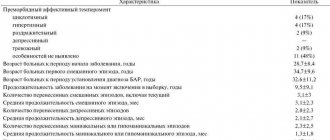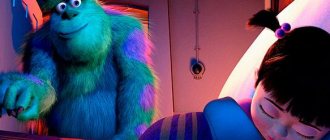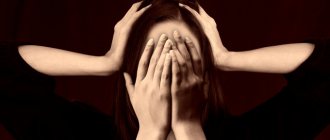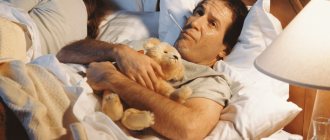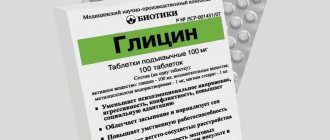Schizoaffective disorder (schizoaffective psychosis) is a condition that simultaneously combines the psychotic symptoms of schizophrenia (delusions, hallucinations) and signs of a mood disorder (depressive and manic).
This pathology is an intermediate link between schizophrenia and bipolar disorder. Due to the combination of elements of different mental illnesses, making a diagnosis presents difficulties that only a specialist with extensive experience can handle. At the same time, it is important to recognize the disease as early as possible - the longer no help is provided, the higher the risk of a protracted, poorly controlled course and worsening of symptoms.
Schizoaffective disorder is an intermediate condition between schizophrenia and bipolar affective disorder.
The set of symptoms is called affective-paranoid syndrome. This concept includes two types of manifestations of the disease:
- Depressive-paranoid syndrome is a low mood with hallucinations and delusions of a negative, self-blaming nature.
- Manic-paranoid syndrome is an elevated mood with hallucinations and delusions of a praising nature.
There may be ideas of persecution or influence from ill-wishers, otherworldly forces, alien creatures.
All this leads to severe social dysfunction, contributes to the emergence of suicidal thoughts and intentions, and significantly increases the path to healing. With timely treatment, the disease is successfully controlled, and patients return to normal life and work.
Factors that increase the risk of developing schizoaffective psychosis:
- genetic - having a close relative with schizophrenia, schizoaffective disorder or mood disorder;
- drug use (LSD, cocaine, opiates);
- stressful situations.
There are manic, mixed and depressive types of disorder, each of which is characterized by its own unique symptoms.
Schizoaffective disorder manic type
This variant is characterized by an abrupt onset and vivid symptoms. Schizophrenic symptoms are combined with manic manifestations. Mania in schizophrenia is characterized by sharply elevated mood, delusional ideas of grandeur or persecution, motor agitation, and lack of social inhibition. There is a pathology of desires (increased sexual activity, appetite), aggression is possible.
Manic syndrome is a pathologically elevated mood with agitation. A person grabs hold of everything, gives away property, and can spend many years of savings at once.
In manic schizophrenia, the symptoms of a mood disorder are expressed by the following main manifestations:
- accelerated thinking, distracted attention, slipping from topic, incoherent speech;
- hyperactivity, decreased need for rest and sleep;
- a sharp increase in mood that does not go away even in situations in which this would be expected.
To make a diagnosis, schizophrenic symptoms must also be present: auditory and visual hallucinations, delusions of various contents. This includes delusions of physical influence: a person’s belief in the influence of certain physical forces on him - an electric field, witchcraft, radiation. A frequent variant is delusion of attitude: he perceives all neutral events and remarks not related to the patient as having a negative meaning for him.
Important
If you suspect signs of a mental disorder in yourself or a loved one, you should immediately contact a specialist. Further uncontrolled development of symptoms leads to a worsening of the condition, the emergence of a difficult situation in the family and poses a danger to children and the environment.
It is worth noting the increased risk of developing manic schizophrenia in women in the postpartum period. Hormonal changes, psychological and physical stress are the trigger for the development of the disorder.
Causes
Scientists cannot currently agree on the causes of the disorder. Most scientists adhere to the genetic theory of the development of SAD. It is believed that those people whose relatives were carriers of schizophrenia or affective disorder are “rewarded” with the risk of getting sick.
Another version suggests the presence of a risk gene for schizophrenic conditions. According to the theory, this gene “sleeps” in the body of almost every person, but wakes up under exceptional circumstances. It turns out that everyone has the opportunity to develop recurrent schizophrenia. The theory only assumes the development of this scenario: there is no clear evidence in this regard.
A connection between the disease and epilepsy has been established. The assumption is confirmed by the results of echoencephalography. In patients with SAD, increased excitability of the same brain regions was observed as in schizophrenia.
An interesting fact has been noticed: people born in late winter - early spring suffer more from the disease.
Negative environmental factors play a large role in the formation of the disorder. Firstly, it has been established that the disease more often affects lonely people who lack outside support. Secondly, the cause is negative events in a person’s life. This category includes poverty, forced change of residence, psychological trauma, chronic, acute stress.
The interdependence between drug and alcohol addiction and schizoaffective disorder is established. Both pathological conditions can provoke each other. Psychotropic substances and alcohol are excellent stimulants of the ball. However, the tormenting sensations of the disease subside for some time under the influence of psychotropics. In the future, when the effect of alcohol and drugs lowers the level of dopamine, the condition does not improve - it worsens, turning into a deeper form.
Physiological factors are also considered as a cause: viral infections, head injuries, hormonal surges.
Schizoaffective disorder depressive type
This option combines schizophrenic symptoms with depressive symptoms. The patient is lethargic, inhibited, and experiences feelings of emptiness, sadness and a sense of worthlessness. To this are added hallucinations and delusions typical of schizophrenia.
Main manifestations of depression:
- depression, melancholy;
- loss of interest in life and previous activities;
- fatigue, decreased energy potential, sleep disturbances;
- feelings of guilt and uselessness;
- memory and concentration problems.
The picture of a characteristic depressive-paranoid syndrome includes delusions of various topics. Blaming delusions - a person is convinced that others consider him guilty of committing shameful acts or crimes. With delusions of harm, the patient is sure that they intend to harm him, to rob him. A common variant is delusions of persecution, when a person believes that he is being spied on by military organizations or pursued by witchcraft forces. All this happens against the background of pronounced depressive symptoms.
Important
Depressive syndrome cannot be ignored by a specialist: in the best case, a person stops working, leaving the house, taking care of himself, in the worst case, he may commit suicide.
With this type, the episodes are not as vivid as with manic, but they cannot be ignored. Diagnosis and treatment of schizoaffective disorder of the depressive type must begin as early as possible, because without the intervention of a specialist, this condition tends to last a long time and often leads to suicidal actions.
Difference from similar mental illnesses
It is important to differentiate schizoaffective disorder (SAD) from schizophrenia and affective psychosis (bipolar disorder). The fact is that its symptoms have much in common with schizophrenia: delusional states, hallucinations, asociality, negative symptoms. And such manifestations as hypomania (exaggeration of one’s own dignity, importance, etc.), depressive and mixed states are also characteristic of affective disorder of the bipolar type.
A feature of the schizoaffective state that distinguishes it from these mental disorders: after a competent recovery from the illness, the person is completely restored as an individual and a member of society. He completely loses symptoms of the schizophrenia spectrum, such as decreased volitional activity, altered consciousness, and emotional poverty.
Psychologists emphasize that timely and adequate therapy gives favorable results in a short time. Attacks can recur in the case of a chronic course of the disease, in the absence of its prevention, as well as when incorrect treatment is prescribed (self-medication, low qualifications of a specialist, etc.).
V.I. Dikaya, A.N. Korenev, P.V. Bologov.
Moscow, Russia.
The general principle of identifying schizoaffective psychosis (SAP), based on the mandatory combination in its picture (sequential or simultaneous) of affective disorders with signs of schizophrenia, mainly represented by symptoms of rank I according to K. Schneider, obviously determines the complexity and controversy of an unambiguous syndromic and nosological assessment of this disease . The question of which disorders - affective or delusional - are leading in determining the prognosis and clinical essence of schizoaffective psychosis is still being discussed. The legitimacy of distinguishing SHAP or, conversely, identifying it with affective psychosis and paroxysmal schizophrenia is also being debated. A number of authors support the position on the advisability of a narrower interpretation of the group of schizoaffective psychoses. Moreover, in the ICD-10 classification, the syndromic presentation of schizoaffective psychosis also does not determine its nosographic essence.
The different nature of the outcomes of schizoaffective psychoses, according to modern literature, cannot always be explained by the dependence on the characteristics of typological varieties of affective disorders, their leading pole and dominant polarity during the course of psychosis (3,4,8). Therefore, the need to search for the most significant clinical and clinical-biological parameters that influence the nosological assessment of schizoaffective psychosis and its prognosis has again become obvious.
Identification of affect-dominant and schizodominant forms of schizoaffective psychosis is one of the approaches to clarifying the relationship of schizoaffective psychosis with a group of schizophrenic and affective diseases and clarifying their mutual position in the taxonomy of endogenous psychoses. This clinical division of schizoaffective psychosis is reflected in the American Research Diagnostic Classification (RDC) (9), developed by R. Spitzer, J. Endicott, E. Robbins in 1978, and then modified by other researchers based on the parameter of different quantitative relationships between affective and schizophrenic symptoms both in the structure of a schizoaffective episode and in the course of the disease (2,5,7). The affect-dominant form of schizoaffective psychosis is understood as a disease with a predominance of affective disorders not only in the course of the disease, but also in the picture of the schizoaffective episode itself, provided that schizophrenic symptoms with persistent affective disorders have been present for at least one week. The schizodominant form of SHAP is understood as a disease with a more obvious presentation of schizophrenic symptoms and their relatively longer duration in the disease picture, provided there are no affective disorders for at least one week with remaining schizophrenic symptoms.
However, this division of SHAP does not fully take into account the clinical uniqueness of the structure and dynamics of a schizoaffective attack, but uses only formal signs of existing mental disorders without their psychopathological assessment, which makes it difficult to interpret them in terms of subsequent influence on the course and outcome. We believe that one of the most promising approaches is the search for adequate approaches to the psychopathological and clinical analysis of schizoaffective disorders and the determination of criteria for their prognostic significance.
We carried out psychopathological and clinical differentiation of schizoaffective psychosis, diagnosed in accordance with ICD-10 criteria. According to these criteria, the severity of affective disorders in the picture of a schizoaffective attack corresponded to moderate or severe depression or mania, and non-affective (schizophrenic) disorders included signs “a-d” from the list of mandatory criteria for diagnosing schizophrenia. The selection of patients was carried out taking into account the presence of at least 3 phases/attacks, including the manifest state. Statistical processing of the material and assessment of the reliability of the compared values was carried out using the x test and Student's test on an IBM-PC 486 PC using the Pearson and SPSS 6.1 programs in the laboratory of mathematical analysis of the Scientific Center for Scientific Research of the Russian Academy of Medical Sciences (head - S.A. Sudakov, performer - A.M. .Amosova).
153 patients were examined using clinical-psychopathological and clinical-follow-up methods. Of these, 76 patients (71 women, 5 men) had an affect-dominant form of SHAP, and 77 patients (70 women, 7 men) had a schizodominant form. In all cases, the disease manifested itself in middle age (at 26.7 years and 27.5 years, respectively). The follow-up period varied from 2 to 35 years and averaged 7.9 years and 6.5 years, respectively.
Clinical and psychopathological differentiation of manifest schizoaffective states of the affect-dominant form of schizoaffective psychosis revealed its clinical heterogeneity. The unifying properties of the structure of a manifest schizoaffective attack were the clear predominance of affective disorders over delusional ones (their average ratio is 20:1), as well as the consistent alternation in the dynamics of the schizoaffective state of the following stages: 1) initial affective disorders; 2) affective delirium; 3) actual delusional (non-affective) disorders and 4) final affective disorders at the stage of reverse development of the attack. It was found that in its formation, each schizoaffective state corresponds to characteristics of these stages that differ in duration and degree of completeness of psychopathological symptoms. That is, in the stereotype of the development of psychosis, it was possible to trace, with a certain degree of convention, a sequential change of independent syndromes at each of the stages - affective, affective delirium and non-affective delirium.
The clinical study showed that despite the obvious predominance of affective disorders in the picture of schizoaffective psychosis, the most preferable principle was its division according to the characteristics of delusional disorders and the mechanisms of delusion formation, which largely reflected information about the characteristics of the course of the disease. At the same time, neither the typological features nor the polarity of affective disorders had a leading prognostic value in determining the prognosis of the disease as a whole.
In accordance with this principle of separation, 3 types of affect-dominant schizoaffective states were identified, in which delusional disorders were determined by a picture of acute sensory delirium in the form of acute delirium of perception, acute visual-figurative delirium of the imagination and acute intellectual delirium of the imagination (according to S.Yu. Tsirkin, 1991) ( 1). Each type of delusion was associated with a preferred pattern of depression or mania.
Type I affect-dominant states were determined by delusions of perception (31 patients, 40.8%), developed more often after psychogenic episodes and most often against the background of depressive affect (84.4%), lasting from 1 to 3 months and, as a rule, after depression, more often apatho -adynamic in nature (48.4%), less often after classical melancholic depressions (12.9%) and even less often after cheerful manias (9.6%). The formation of delusions of perception was preceded by the stage of “isolated” and the most persistent affective delusions ( lasting 1-2 weeks), which was most pronounced on the eve of a delusional mood, when the ideas of sinfulness and guilt acquired a global character. The succeeding picture of transient delusion of perception most often corresponded to the delusion of staging - 67.7%, in 19.4% it was limited to a delusional mood and only in 12.9% - delusion of symbolic meaning. At the height of psychosis, delusional affect itself dominated in the form of confusion or anxious tension with a persecutory connotation of the content of experiences. The exit from psychosis was critical, with the exit into depression of the same type and complete criticism of the period of illness. After the reduction of delusional disorders themselves, manifestations of depressive delusions again came to the fore, which were reduced within 2-3 weeks, and affective disorders persisted for another 1.5-3 months. In general, the duration of the schizoaffective state was 7.5 months and it was shortest in the subtype with delusional mood (5.6 months), and longer with delusions of symbolic meaning (10.5 months).
The subsequent course of the disease when manifesting type I affect-dominant schizoaffective state was close to phase, with a relatively low frequency of phases (0.61 per year) with relatively long remissions (24.4 months), and the frequency of affective and schizoaffective phases was the same (0.3 and 0.31). In the dynamics of the disease, the majority of patients had affective disorders of a bipolar nature, but only here the unipolar depressive type of affect was most represented (40.6%). In 65.6% of patients, after 3-5 years the disease passed to a purely affective level or proceeded with repeated attacks of the “cliché” type. In remissions, transient features of asthenia were noted, the premorbid personality structure was preserved, and indicators of social and labor adaptation remained high.
Type II affect-dominant states (32 patients, 42.1%) were characterized by visual-figurative delirium of the imagination, which did not have a specific interpretation in its content and developed both autochthonously and after somatogeny and mainly against the background of manic affect (in 79.2% of cases ), which was represented in approximately equal proportions by psychopathic-like and classical manias and manias with ideational confusion. Unlike type I affect-dominant states, affective delusions appeared here not only as an independent stage of the schizoaffective state, but often remained in parallel with the development of non-affective delusional disorders. Only at the height of the psychotic state were its manifestations fragmented and supplanted by actual delusional disorders of the type of “delusional ideas” with a simultaneous decrease in the severity of affective delusions and an increase in the delusional affect of anxiety and confusion. The simultaneous coexistence of affective and non-affective delusions created a pronounced syndromic polymorphism of delusional disorders in the picture of a schizoaffective attack and a rapid transition to onirism. The recovery from psychosis in a schizoaffective attack was closer to critical; at the stage of reverse development of the schizoaffective state, manic affect with manic delusional disorders again dominated. Once the affect-dominant state of type II had passed, a somewhat formal criticism of the psychosis developed. Its average duration was 7.9 months.
The further course of schizoaffective psychosis here was also relatively favorable, as if intermediate between phase dynamics and close to a recurrent paroxysmal course. Subsequent attacks developed more often autochthonously, according to the “cliché” type. In 61.5% of patients, the disease was regressive in nature with a transition to a purely affective level of disorders. The average frequency of attacks per year here was higher than in type I conditions (0.9), the duration of remissions was shorter (18.9 months). The ratio of attacks of the affective and schizoaffective structure was almost equal (0.45 and 0.43, respectively) . In the dynamics of the disease as a whole, the bipolar type of affective disorders with a predominance of manic disorders clearly dominated. In remissions, personality changes were noticeable with a clear sharpening of pre-manifest hysteroschizoid characteristics, traits of rationalism, and mental rigidity without a subsequent deepening of personality characteristics as the period of follow-up increased. There was a slight decrease in professional level (in 1/3 of the patients), but in general all patients remained able to work.
Type III affect-dominant states were distinguished by the development in the picture of an attack of intellectual delirium of the imagination (13 patients, 17.1%). Its occurrence was only autochthonous and mainly against the background of manic affect, usually of a psychopathic nature. In the dynamics of the attack, the stage of full-blown manic disorders was followed by the stage of atypical manic delirium, with elements of ideational development, like fiction. With the further development of the attack, against the background of a pathologically enhanced ideational component of the imagination, the formation of delusional disorders proper took place according to the type of intuitive delusional “guess”. At the height of delusional psychosis, inventions of paraphrenic content prevailed, signs of dreaminess were absent. The reduction of delusional disorders took place lytically and ended with a return to manic delusions and then to “purely” manic disorders within 3-5 months. The duration of manifest affect-dominant state type III averaged 6.7 months.
The subsequent dynamics of the disease were paroxysmal and progressive in nature. With a total frequency of attacks of 0.8 per year, their average duration was twice as long as in types I and II of conditions, respectively, and remissions were shorter (up to 9.3 months). In terms of frequency, schizoaffective attacks prevailed over affective ones in the dynamics of the disease ( 0.49 and 0.31, respectively). Characteristic was the continuum type of course of affective disorders. In 100% of patients, bipolar affect occurred with a clear predominance of the manic pole of affect, with the frequent subsequent formation of unipolar manic disorders. The transition to the affective level was relatively rare here. In remissions, negative personality changes were clearly detected in the form of an increase in emotional deficiency, decreased productivity, and thinking disorders. Here there were lower rates of social and labor adaptation than with types I and II of affect-dominant states.
Thus, the clinical heterogeneity of diseases united by the concept of an affect-dominant form of schizoaffective psychosis has been revealed. A reliable relationship was found between the identified typological variants of schizoaffective states and the types of further course of the disease. They did not find a definite relationship with the leading polarity of affect in the dynamics of the disease: in all types of the course of affect-dominant schizoaffective psychosis, bipolar affect was dominant (76.5%), which confirms the validity of using other principles of their clinical separation.
Clinical and psychopathological differentiation within the schizodominant form of schizoaffective psychosis also revealed the heterogeneity of its manifestations and the dynamics at different stages of the formation of the schizoaffective state. In contrast to the affect-dominant form in the picture of a schizoaffective attack, the stage of delusional disorders proper here was longer, from 1.5 months to 4.5 months, and the ratio of affective and non-affective delusional disorders was 1.5:1. The sequential change in the stages of formation of the schizoaffective state was unclear, the manifestations of each of them were often layered on top of each other. Manifestations of affective delusions were formed, as a rule, with non-affective delusions and coexisted in the picture of a schizoaffective state. Psychopathological manifestations of delusional disorders themselves always reached a paranoid level and differed from affect-dominant ones in that they necessarily included mixed mechanisms of their formation with the participation of both acute sensory and ideational forms of trouble.
Depending on the prevailing mechanisms of delusion formation in the structure of delusional (paranoid) disorders, 3 types of schizodominant states are identified - which developed as paranoid psychoses in the picture of acute delusions of perception with elements of interpretation (Type I), in the structure of visual-figurative delusions of imagination with elements of interpretation (II type) and based on acute interpretive delusion (type III). In general, there was no reliable relationship between these types of schizoaffective states with clinical, typological manifestations, the type of polarity in the dynamics of the disease and the pole of affect in the attack. Regardless of the types of course and schizodominant schizoaffective psychosis, bipolar affect was dominant in the dynamics of the disease (in 96% of cases).
Type I schizodominant conditions (23 patients, 30%) were characterized by the development of paranoid syndrome in the structure of acute delusions of perception with elements of interpretation. It was formed autochthonously and only in 30.4% after psychogenicity in most cases (87%) against the background of previous asthenic-adynamic depressions for 1-2.5 months. On the eve of the development of distress psychosis itself, individual ideas of relationship with unstable persecutory content appeared in the structure of depression. There was no independent stage of affective delusion observed here; only some of its manifestations were layered on the delusional manifestations of the subsequent stage of delusional disorders proper. In their picture, circular affect was completely replaced by distress, with paranoid symptoms and the development in its structure of manifestations of acute Kandinsky-Clerambault syndrome, closely associated in its manifestations with acute sensory delirium of perception, but with an attempt at a delusional interpretation of facts, events and, less often, with a fantastic modification delirium and psychotic affect. The duration of the stage of delusional disorders itself was 1.5 months. The way out of psychosis was lytic. With the reverse dynamics of the disorders, the same circular affect that took place at the initial stages of the attack began to dominate again, its duration did not exceed 3 weeks. The total duration of the entire type I schizodominant state averaged 4.3 months. A fairly complete criticism was formed during the period of illness.
The further course of the disease was intermediate in nature between the phase and recurrent course with a relatively low overall frequency of attacks (0.64) and the highest duration of remissions (16.3 months). The frequency of affective and schizoaffective episodes in the dynamics of the disease varied slightly (0.29 and 0.35, respectively). In more than half of the cases, a transition of the disease to the affective level was observed. Bipolar affective disorders dominated the dynamics of the disease. The personal make-up of patients as the disease progressed underwent only minor dynamics in the form of a sharpening of the asthenic premorbid personal radical. The level of social and labor adaptation did not change.
Type II schizodominant conditions (24 patients, 31%) were manifested by the development of paranoid syndrome in the structure of visual-figurative delusions of the imagination with elements of interpretive delusions. It developed more often autochthonously and predominantly against the background of inversion of the pole of circular affect, more often when the previous depressive phase was replaced by a manic one. Therefore, the stage of “purely” affective disorders here did not exceed 5-7 days, and then in the picture of affective disorders, both affective and non-affective delusional disorders formed in parallel with each other and the state became polymorphic. Actually, delusional disorders arose according to the type of “delusional ideas”, “sudden thoughts”, were accompanied by elements of interpretation and reached acute Kandinsky-Clerambault syndrome with transformation into delusional depersonalization of fantastic content, sometimes with elements of oneirism. The duration of the period of non-affective delirium was about 2 months. The recovery from delusional psychosis was lytic with a return to manifestations of affective disorders of the same pole lasting up to 1-2 months. The average duration of this condition was 5.2 months. Formal criticism was formed only during the acute period of the illness. After a manifest schizodominant attack, most patients experienced a clear personality shift with the appearance of noticeable autism and increased signs of emotional deficiency, mental rigidity with regressive syntony.
The course of the disease was defined as paroxysmal-progressive. The overall frequency of attacks here was higher (0.99), and the duration of remissions was shorter (13.8 months). The frequency of affective and schizoaffective episodes was almost equal (0.49 and 0.5). During the course of the disease, a distinctly bipolar type of affect predominated. The transition of the disease to the affective level was quite rare. The structure of repeated attacks during the course of the disease was simplified, but they became more protracted. A decrease in indicators of social and labor adaptation was noted in 41.6%.
Type III schizodominant states (30 patients, 39%) included a paranoid state developing on the basis of acute interpretative delusions. They were formed autochthonously against the background of apatho-adynamic depression in 60% or psychopathic-like mania in 40%. The duration of the stage of purely affective disorders did not exceed 2 weeks. Psychopathological manifestations of the stage of delusional disorders proper arose subacutely with the parallel formation of paranoid disorders and affective delusions, which receded into the background at the height of paranoid psychosis, but during the period of reduction of disorders occupied a dominant position in the picture of the condition. In the structure of a schizodominant attack, the defining factors were Kandinsky-Clerambault syndrome with elements of acute sensory delusion in the form of an undeveloped staging syndrome, isolated false recognitions in combination with circular affect. The duration of the period of delusional disorders itself was on average 2.5 months, and the overall duration of the attack was from 3 to 6 months. During the period of reduction of disorders, a change in the pole of affect to the opposite was often observed, and after the schizoaffective state had passed, almost half of the patients showed residual delusions.
The subsequent dynamics of the disease were defined as fur coat-like with pronounced progression. There was no transition of the disease to the affective level. A protracted course of attacks with a tendency to chronicity was often noted. The overall duration of remissions was lower here (11.2 months), and the frequency of schizoaffective attacks averaged 1.07 per year. Negative personality changes increased after each attack and were expressed in autism, emotional impoverishment, decreased mental productivity with impaired thinking.
Thus, the presented clinical differentiation of manifest schizoaffective states according to the characteristics of non-affective delusions in their picture provides prognostic information for assessing the course of schizoaffective psychosis as a whole and reveals differences in the types of its dynamics (phases, attacks, fur coats) and the degree of its progression. They confirm the clinical heterogeneity of schizoaffective psychosis and allow us to consider it as a nosologically and clinically combined group of disorders united under the general name of schizoaffective psychosis. True or “core” forms include affect-dominant schizoaffective psychoses manifested by delusions of perception (type I affect-dominant states), which do not show progression,
despite schizophrenic delusional manifestations during an attack, they have a phase dynamics of disorders and in terms of prognosis are the most favorable. “Extreme” or intermediate forms of schizoaffective psychosis include affect-dominant forms of schizoaffective psychosis with a picture of visual-figurative delirium of the imagination in a schizoaffective attack (type II affect-dominant states). Edge forms also include schizodominant forms of schizoaffective psychosis, which manifest themselves as acute paranoid syndrome in the structure of delusions of perception with elements of interpretation in the picture of the attack (type I schizodominant state). Both of these varieties have a phase-recurrent nature of the course of the disease, do not show signs of progression and also have a relatively favorable prognosis. In progressive varieties of schizoaffective psychosis, in which the formation of delusional disorders in the picture of schizoaffective states occurs with the participation of ideational forms of delirium - type III affect-dominant states with a picture of intellectual delirium of the imagination and types II and III of schizodominant states, characterized by paranoid syndrome in the structure of visual-figurative delusions with elements interpretation or in the structure of acute interpretive delusion. The course of the disease in these cases corresponded to the schizoaffective variant of fur coat-like schizophrenia. The established clinical and nosological heterogeneity of schizoaffective psychoses is confirmed by the results of neurophysiological, biochemical and experimental psychological studies conducted in parallel with the clinical analysis of schizoaffective psychoses.
LITERATURE
1. Tsirkin S.Yu. Differential diagnosis of conditions with delusions of imagination // Current issues in psychiatry and narcology: Abstracts of the IV Congress of Psychiatrists and Narcologists of the Perm Region - Perm, 1991-pp. 15-16
2.Angst J. Verlauf und Ausgang affektiver und schizo-affektiver Erkrankungen in: Huber G. ed. Zyklothymie-offene Fragen. Artl. Gessprach-1986-Bd.41-s.41-82
3.Black DW, Winocur G., Nasrallah A., Brewin A. Psychotic symptoms and age of onset in affective disorder // Psychopathology-1992- v.25 -N-1- p.19-22.
4. Coryell W., Keller M., Lavori Ph., Endicott J. Affective Syndromes, Psychotic Features and Prognosis//Arch.gen.psychiatry- 1990 - v.47- N-6- p.651-662
5.Marneros A., Deister A., Rohde A., Junemann H and Fimers R. Long-Term Course of Schizoaffective Disorders//Eur.Arch.Psychiatry Neurol.Sci- 1988- v.237 -p.264-275
7.Marneros A., Deister A., Rohde A. The Concept of Distinct but Voluminous Groups of Bipolar and Unipolar Diseases // Eur. Arch. Psychiatry Clin. Neurosci- 1990 - v.240 - p.77-84
8.Mc.Glashan TH,Williams PV Predicting Outcome in Schizoaffective Psychosis// J.Nerv.Ment.Dis.-1990-v.178-N-8-p.518-520
9. Spitzer RL, Endicott J., Robins E. Research Diagnostic Criteria for a Selected Group of Functional Disorders (RDC) -ed.2, New York- Biometrics Research Division, New York Psychiatric Institute-1978
Cases from medical practice
The following example from a doctor’s practice demonstrates how difficult it can be for a specialist to diagnose a mental disorder of a schizoaffective nature and to separate it from diseases of the same type.
A young and self-sufficient woman, a mother of three children, several months after breaking up with her partner, began to suffer from acute psychosis. Some time after this event, she began to hear voices. It seemed to her that the whole world was against her, everyone wanted her dead and was trying to kill her. At the same time, she clearly felt how a conspiracy was forming around her.
The patient almost stopped sleeping, fearing for her life, and eating, since, in her opinion, all the food was poisoned. During this period, she completely withdrew into herself and practically stopped leaving the room and communicating with her family. Her children took care of all the household chores.
Her family convinced her to see a doctor. After two months of treatment, the woman felt much better and returned to normal. This state lasted for a week and a half, after which she began to experience apathy, depression, and any motivation and interest in life disappeared.
The woman could not read or watch TV due to lack of concentration. Often her condition changed to the radically opposite: the patient laughed for no reason, talked about her importance and necessity in society, and was proud of her everyday actions. After a re-examination by a specialist, he urgently adjusted the therapy.
At this time, the woman feels stable and natural. This example is a clear indication of how difficult it is to initially identify a disease such as schizoaffective disorder. If at first all the symptoms indicated the initial stage of schizophrenia, then its subsequent behavior can be clearly explained by the mixed type of this disease.

